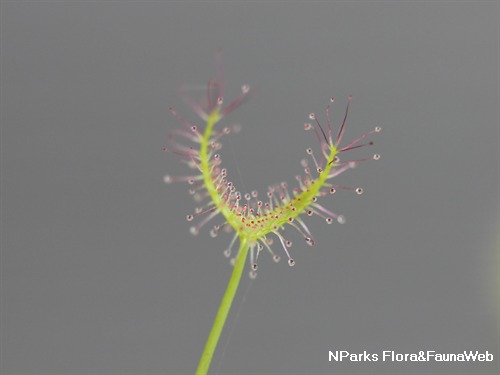
Name
Classifications and Characteristics
| Plant Division | Angiosperms (Flowering Seed Plants) (Dicotyledon) |
|---|---|
| Plant Growth Form | Herbaceous Plant |
| Lifespan (in Singapore) | Perennial |
| Mode of Nutrition | Autotrophic, Heterotrophic |
Biogeography
| Native Distribution | Australia |
|---|---|
| Native Habitat | Terrestrial |
| Preferred Climate Zone | Sub-Tropical / Monsoonal |
| Local Conservation Status | Non-native |
Description and Ethnobotany
| Growth Form | Pygmy, rosette-forming sundew up to 2-3 cm wide. In nature, it is an annual, but under cultivation, it can live for several years. |
|---|---|
| Roots | The roots are long and thin. |
| Foliage | The red, circular leaf blade is densely covered in long, red tentacles. The yellow-green petiole is about 2 times the diameter of the leaf blade. Leaves are arranged in a rosette like the spokes of a wheel. |
| Flowers | Pink, star-shaped flowers are composed of 5 oval petals. |
| Habitat | This naturally occurring hybrid can be found near lakes, creeks or low-growing shrubs and in open forested areas. |
| Taxonomy | Drosera x carbarup is the hybrid of Drosera occidentalis and Drosera platystigma. This hybrid forms naturally in the wild. |
| Cultivation | Plant this hybrid in a mix of 1:1 coarse peat moss to sand/ perlite (or up to 1:3 for better drainage). Provide as much sunlight as possible, but it will also grow on a sunny windowsill. This hybrid is not suitable for closed terrariums, because a relative humidity of 80% or more will likely kill the plant. In Singapore, it is best grown indoors in an air-conditioned environment, because the air outside is too humid, having an average relative humidity of 80%. |
| Etymology | The genus Drosera comes from the Greek word for dew ("drosos"). It refers to the dew-like mucilage produced by the leaves which help trap insects. |
Landscaping Features
| Desirable Plant Features | Ornamental Foliage |
|---|---|
| Landscape Uses | Interiorscape/ Indoor Plant, Container Planting, Terrarium |
| Thematic Landscaping | Marsh Garden |
Plant Care and Propagation
| Light Preference | Full Sun |
|---|---|
| Water Preference | Lots of Water |
| Plant Growth Rate | Fast |
| Rootzone Tolerance | Moist Soils, Well-Drained Soils |
| Propagation Method | Seed |
Foliar
| Foliage Retention | Evergreen |
|---|---|
| Mature Foliage Colour(s) | Red |
| Mature Foliage Texture(s) | Sticky |
| Prominent Young Flush Colour(s) | Red |
| Young Flush Texture(s) | Sticky |
| Foliar Modification | Sticky Trap |
| Foliar Type | Simple / Unifoliate |
| Foliar Arrangement Along Stem | Rosulate / Rosette |
| Foliar Attachment to Stem | Petiolate |
| Foliar Shape(s) | Non-Palm Foliage (Orbicular / Round) |
| Foliar Venation | Reticulate |
| Foliar Margin | Entire |
| Foliar Apex - Tip | Rounded |
| Foliar Base | Rounded / Obtuse |
| Typical Foliar Area | Nanophyll ( 0.25cm2 - 2.25 cm2 ) |
Floral (Angiosperm)
| Flower & Plant Sexuality | Bisexual Flowers |
| Flower Colour(s) | Pink |
|---|---|
| Flower Texture(s) | Smooth |
| Flower Grouping | Cluster / Inflorescence |
| Flower Location | Terminal |
| Flower Symmetry | Radial |
| Individual Flower Shape | Stellate / Star-shaped |
| Inflorescence Type | Raceme |
| Flowering Period | Free-Flowering |
| Flowering Opening Time | Daytime |
| Flower Lifespan on Plant | 1 Day |
| Flowering Habit | Polycarpic |
Image Repository
Others
| Master ID | 32863 |
|---|---|
| Species ID | 7277 |
| Flora Disclaimer | The information in this website has been compiled from reliable sources, such as reference works on medicinal plants. It is not a substitute for medical advice or treatment and NParks does not purport to provide any medical advice. Readers should always consult his/her physician before using or consuming a plant for medicinal purposes. |






